 développement back-end
développement back-end
 Tutoriel Python
Tutoriel Python
 Introduction aux bibliothèques d'apprentissage automatique et d'apprentissage profond couramment utilisées en python (partage de résumé)
Introduction aux bibliothèques d'apprentissage automatique et d'apprentissage profond couramment utilisées en python (partage de résumé)
Introduction aux bibliothèques d'apprentissage automatique et d'apprentissage profond couramment utilisées en python (partage de résumé)
Cet article vous apporte des connaissances pertinentes sur python. Il présente principalement un résumé de la bibliothèque d'apprentissage automatique et d'apprentissage profond, qui contient un grand nombre d'exemples. Examinons-le ensemble, j'espère qu'il sera utile à tout le monde.
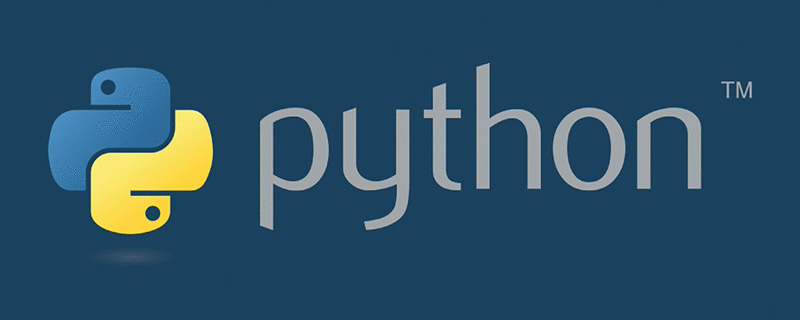
Apprentissage recommandé : Tutoriel vidéo Python
Avant-propos
À l'heure actuelle, avec la popularité de l'intelligence artificielle, elle a attiré l'attention de nombreuses industries sur l'intelligence artificielle, et en même temps, elle a a également marqué le début d'une recrudescence de l'apprentissage de l'intelligence artificielle. Bien que les principes qui sous-tendent l'intelligence artificielle ne puissent pas être présentés en détail dans un court article, comme toutes les disciplines, nous n'avons pas besoin d'« inventer la roue » à partir de zéro. utilisez un riche cadre d'intelligence artificielle pour créer des modèles d'intelligence artificielle afin de vous lancer dans la tendance de l'intelligence artificielle.
L'intelligence artificielle fait référence à une série de technologies qui permettent aux machines de traiter des informations comme les humains ; l'apprentissage automatique est le processus d'utilisation de la programmation informatique pour apprendre à partir de données historiques et prédire de nouvelles données basées sur la structure et les caractéristiques des cerveaux biologiques ; Modèle informatique d'apprentissage automatique ; l'apprentissage profond est un sous-ensemble de l'apprentissage automatique qui traite de grandes quantités de données non structurées telles que la parole humaine, le texte et les images. Ces concepts sont donc hiérarchiquement interdépendants, l'intelligence artificielle étant le terme le plus large et le deep learning le plus spécifique :
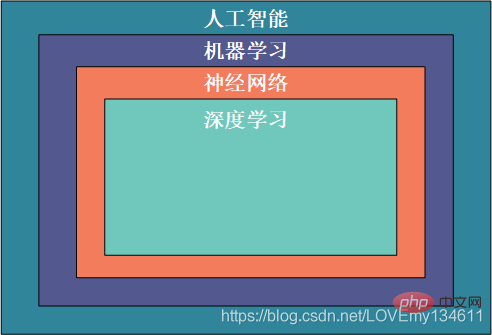
Afin que chacun se familiarise avec la bibliothèque Python couramment utilisée pour les applications artificielles. intelligence Ayez une compréhension préliminaire pour choisir une bibliothèque qui peut répondre à vos besoins d'apprentissage et donnez une introduction brève et complète aux bibliothèques d'intelligence artificielle actuellement les plus courantes. Python 库有一个初步的了解,以选择能够满足自己需求的库进行学习,对目前较为常见的Introduction aux bibliothèques dapprentissage automatique et dapprentissage profond couramment utilisées en python (partage de résumé)库进行简要全面的介绍。

python常用机器学习及深度学习库介绍
1、 Numpy
NumPy(Numerical Python)是 Python的一个扩展程序库,支持大量的维度数组与矩阵运算,此外也针对数组运算提供大量的数学函数库,Numpy底层使用C语言编写,数组中直接存储对象,而不是存储对象指针,所以其运算效率远高于纯Python代码。
我们可以在示例中对比下纯Python与使用Numpy库在计算列表sin值的速度对比:
import numpy as npimport mathimport randomimport time
start = time.time()for i in range(10):
list_1 = list(range(1,10000))
for j in range(len(list_1)):
list_1[j] = math.sin(list_1[j])print("使用纯Python用时{}s".format(time.time()-start))start = time.time()for i in range(10):
list_1 = np.array(np.arange(1,10000))
list_1 = np.sin(list_1)print("使用Numpy用时{}s".format(time.time()-start))从如下运行结果,可以看到使用 Numpy 库的速度快于纯 Python 编写的代码:
使用纯Python用时0.017444372177124023s 使用Numpy用时0.001619577407836914s
2、 Introduction aux bibliothèques dapprentissage automatique et dapprentissage profond couramment utilisées en python (partage de résumé)
Introduction aux bibliothèques dapprentissage automatique et dapprentissage profond couramment utilisées en python (partage de résumé) 是一个的跨平台计算机视觉库,可以运行在 Linux、Windows 和 Mac OS 操作系统上。它轻量级而且高效——由一系列 C 函数和少量 C++ 类构成,同时也提供了 Python 接口,实现了图像处理和计算机视觉方面的很多通用算法。
下面代码尝试使用一些简单的滤镜,包括图片的平滑处理、高斯模糊等:
import numpy as npimport cv2 as cvfrom matplotlib import pyplot as plt
img = cv.imread('h89817032p0.png')kernel = np.ones((5,5),np.float32)/25dst = cv.filter2D(img,-1,kernel)blur_1 = cv.GaussianBlur(img,(5,5),0)blur_2 = cv.bilateralFilter(img,9,75,75)plt.figure(figsize=(10,10))plt.subplot(221),plt.imshow(img[:,:,::-1]),plt.title('Original')plt.xticks([]), plt.yticks([])plt.subplot(222),plt.imshow(dst[:,:,::-1]),plt.title('Averaging')plt.xticks([]), plt.yticks([])plt.subplot(223),plt.imshow(blur_1[:,:,::-1]),plt.title('Gaussian')plt.xticks([]), plt.yticks([])plt.subplot(224),plt.imshow(blur_1[:,:,::-1]),plt.title('Bilateral')plt.xticks([]), plt.yticks([])plt.show()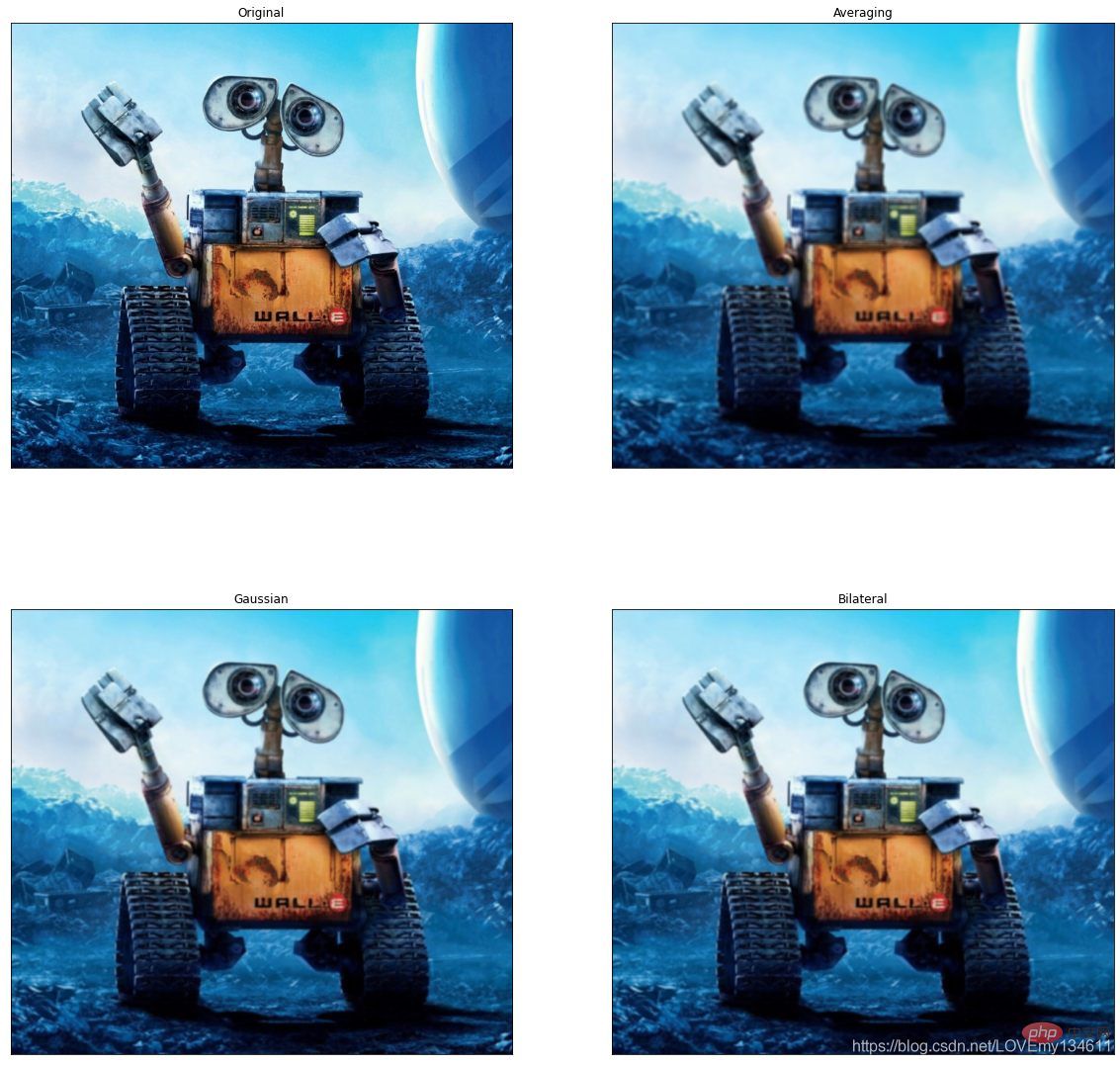
可以参考Introduction aux bibliothèques dapprentissage automatique et dapprentissage profond couramment utilisées en python (partage de résumé)图像处理基础(变换和去噪),了解更多 Introduction aux bibliothèques dapprentissage automatique et dapprentissage profond couramment utilisées en python (partage de résumé) 图像处理操作。
3、 Introduction aux bibliothèques dapprentissage automatique et dapprentissage profond couramment utilisées en python (partage de résumé)
scikit-image是基于scipy的图像处理库,它将图片作为numpy数组进行处理。
例如,可以利用scikit-image改变图片比例,scikit-image提供了rescale、resize以及downscale_local_mean等函数。
from skimage import data, color, iofrom skimage.transform import rescale, resize, downscale_local_mean
image = color.rgb2gray(io.imread('h89817032p0.png'))image_rescaled = rescale(image, 0.25, anti_aliasing=False)image_resized = resize(image, (image.shape[0] // 4, image.shape[1] // 4),
anti_aliasing=True)image_downscaled = downscale_local_mean(image, (4, 3))plt.figure(figsize=(20,20))plt.subplot(221),plt.imshow(image, cmap='gray'),plt.title('Original')plt.xticks([]), plt.yticks([])plt.subplot(222),plt.imshow(image_rescaled, cmap='gray'),plt.title('Rescaled')plt.xticks([]), plt.yticks([])plt.subplot(223),plt.imshow(image_resized, cmap='gray'),plt.title('Resized')plt.xticks([]), plt.yticks([])plt.subplot(224),plt.imshow(image_downscaled, cmap='gray'),plt.title('Downscaled')plt.xticks([]), plt.yticks([])plt.show()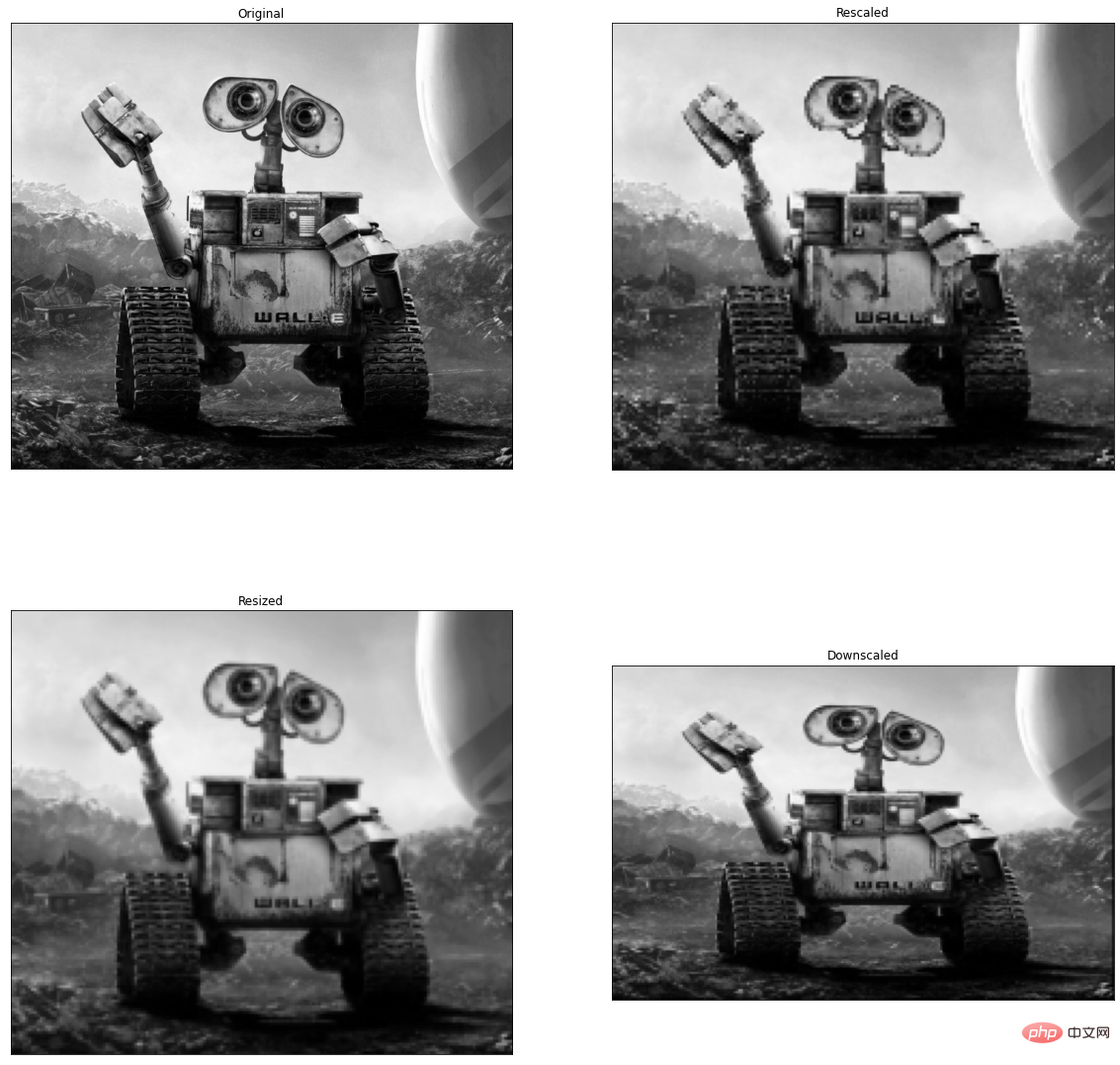
4、 Python Imaging Library(PIL)
Python Imaging Library(PIL) 已经成为 Python 事实上的图像处理标准库了,这是由于,PIL 功能非常强大,但API却非常简单易用。
但是由于PIL仅支持到 Python 2.7,再加上年久失修,于是一群志愿者在 PIL 的基础上创建了兼容的版本,名字叫 Pillow,支持最新 Python 3.x,又加入了许多新特性,因此,我们可以跳过 PIL,直接安装使用 Pillow。
5、 Pillow
使用 Pillow


NumPy (Python numérique) est Python<. une biblioth d de code> qui prend en charge un grand nombre d'opérations sur les tableaux dimensionnels et les matrices. De plus, elle fournit également un grand nombre de bibliothèques de fonctions mathématiques pour les opérations sur les tableaux. La couche inférieure de <code>Numpy est écrite. en langage C, les objets sont stockés directement dans le tableau au lieu de pointeurs d'objet, donc son efficacité opérationnelle est bien supérieure à celle du code Python pur. Nous pouvons comparer la vitesse de calcul de la valeur sin d'une liste entre
Pure Python et en utilisant la Bibliothèque Numpy dans l'exemple : 🎜from PIL import Image, ImageDraw, ImageFont, ImageFilterimport random# 随机字母:def rndChar():
return chr(random.randint(65, 90))# 随机颜色1:def rndColor():
return (random.randint(64, 255), random.randint(64, 255), random.randint(64, 255))# 随机颜色2:def rndColor2():
return (random.randint(32, 127), random.randint(32, 127), random.randint(32, 127))# 240 x 60:width = 60 * 6height = 60 * 6image = Image.new('RGB', (width, height), (255, 255, 255))# 创建Font对象:font = ImageFont.truetype('/usr/share/fonts/wps-office/simhei.ttf', 60)# 创建Draw对象:draw = ImageDraw.Draw(image)# 填充每个像素:for x in range(width):
for y in range(height):
draw.point((x, y), fill=rndColor())# 输出文字:for t in range(6):
draw.text((60 * t + 10, 150), rndChar(), font=font, fill=rndColor2())# 模糊:image = image.filter(ImageFilter.BLUR)image.save('code.jpg', 'jpeg')Numpy est plus rapide que le code écrit en Python pur : 🎜from SimpleCV import Image, Color, Display# load an image from imgurimg = Image('http://i.imgur.com/lfAeZ4n.png')# use a keypoint detector to find areas of interestfeats = img.findKeypoints()# draw the list of keypointsfeats.draw(color=Color.RED)# show the resulting image. img.show()# apply the stuff we found to the image.output = img.applyLayers()# save the results.output.save('juniperfeats.png')🎜2, Introduction aux bibliothèques dapprentissage automatique et dapprentissage profond couramment utilisées en python (partage de résumé)🎜
🎜Introduction aux bibliothèques dapprentissage automatique et dapprentissage profond couramment utilisées en python (partage de résumé) est un cross- bibliothèque de plate-forme Computer Vision pouvant fonctionner sur les systèmes d'exploitation Linux, Windows et Mac OS. Il est léger et efficace : il se compose d'une série de fonctions C et d'un petit nombre de classes C++. Il fournit également une interface Python pour implémenter de nombreux algorithmes courants dans le traitement d'images et la vision par ordinateur. Le code suivant tente d'utiliser des filtres simples, notamment le lissage d'image, le flou gaussien, etc. : 🎜
SyntaxError: Missing parentheses in call to 'print'. Did you mean print('unit test')? 🎜🎜Vous pouvez vous référer aux bases du traitement d'image Introduction aux bibliothèques dapprentissage automatique et dapprentissage profond couramment utilisées en python (partage de résumé) (transformation et débruitage) pour en savoir plus sur les opérations de traitement d'image Introduction aux bibliothèques dapprentissage automatique et dapprentissage profond couramment utilisées en python (partage de résumé). 🎜
🎜🎜Vous pouvez vous référer aux bases du traitement d'image Introduction aux bibliothèques dapprentissage automatique et dapprentissage profond couramment utilisées en python (partage de résumé) (transformation et débruitage) pour en savoir plus sur les opérations de traitement d'image Introduction aux bibliothèques dapprentissage automatique et dapprentissage profond couramment utilisées en python (partage de résumé). 🎜🎜3, Introduction aux bibliothèques dapprentissage automatique et dapprentissage profond couramment utilisées en python (partage de résumé)🎜
🎜scikit-image est une bibliothèque de traitement d'images basée sur scipy, qui utilise des images comme numpy tableau pour le traitement. <br> Par exemple, vous pouvez utiliser <code>scikit-image pour modifier le rapport de l'image. scikit-image fournit un rescale et un resize. Et des fonctions telles que downscale_local_mean. 🎜import numpy as npimport mahotasimport mahotas.demosfrom mahotas.thresholding import soft_thresholdfrom matplotlib import pyplot as pltfrom os import path
f = mahotas.demos.load('lena', as_grey=True)f = f[128:,128:]plt.gray()# Show the data:print("Fraction of zeros in original image: {0}".format(np.mean(f==0)))plt.imshow(f)plt.show() 🎜
🎜🎜4、 Python Imaging Library(PIL)🎜
🎜Python Imaging Library(PIL) est devenue de facto la bibliothèque standard de traitement d'image de Python. code >PIL est très puissant, mais l'API est très simple et facile à utiliser. Cependant, comme PIL ne prend en charge que
Python 2.7 et est en mauvais état, un groupe de bénévoles a créé une version compatible basée sur PIL, nommée Elle s'appelle Pillow , prend en charge le dernier Python 3.x et ajoute de nombreuses nouvelles fonctionnalités. Par conséquent, nous pouvons ignorer PIL et l'installer et l'utiliser directement code>Pillow<.>. 🎜🎜5, Pillow🎜
🎜UtilisezPillow pour générer une image de code de vérification de lettre : 🎜import timeimport numpy as npimport matplotlib.pyplot as pltfrom sklearn.cluster import MiniBatchIntroduction aux bibliothèques dapprentissage automatique et dapprentissage profond couramment utilisées en python (partage de résumé), Introduction aux bibliothèques dapprentissage automatique et dapprentissage profond couramment utilisées en python (partage de résumé)from sklearn.metrics.pairwise import pairwise_distances_argminfrom sklearn.datasets import make_blobs# Generate sample datanp.random.seed(0)batch_size = 45centers = [[1, 1], [-1, -1], [1, -1]]n_clusters = len(centers)X, labels_true = make_blobs(n_samples=3000, centers=centers, cluster_std=0.7)# Compute clustering with Meansk_means = Introduction aux bibliothèques dapprentissage automatique et dapprentissage profond couramment utilisées en python (partage de résumé)(init='k-means++', n_clusters=3, n_init=10)t0 = time.time()k_means.fit(X)t_batch = time.time() - t0# Compute clustering with MiniBatchIntroduction aux bibliothèques dapprentissage automatique et dapprentissage profond couramment utilisées en python (partage de résumé)mbk = MiniBatchIntroduction aux bibliothèques dapprentissage automatique et dapprentissage profond couramment utilisées en python (partage de résumé)(init='k-means++', n_clusters=3, batch_size=batch_size,
n_init=10, max_no_improvement=10, verbose=0)t0 = time.time()mbk.fit(X)t_mini_batch = time.time() - t0# Plot resultfig = plt.figure(figsize=(8, 3))fig.subplots_adjust(left=0.02, right=0.98, bottom=0.05, top=0.9)colors = ['#4EACC5', '#FF9C34', '#4E9A06']# We want to have the same colors for the same cluster from the# MiniBatchIntroduction aux bibliothèques dapprentissage automatique et dapprentissage profond couramment utilisées en python (partage de résumé) and the Introduction aux bibliothèques dapprentissage automatique et dapprentissage profond couramment utilisées en python (partage de résumé) algorithm. Let's pair the cluster centers per# closest one.k_means_cluster_centers = k_means.cluster_centers_
order = pairwise_distances_argmin(k_means.cluster_centers_,
mbk.cluster_centers_)mbk_means_cluster_centers = mbk.cluster_centers_[order]k_means_labels = pairwise_distances_argmin(X, k_means_cluster_centers)mbk_means_labels = pairwise_distances_argmin(X, mbk_means_cluster_centers)# Introduction aux bibliothèques dapprentissage automatique et dapprentissage profond couramment utilisées en python (partage de résumé)for k, col in zip(range(n_clusters), colors):
my_members = k_means_labels == k
cluster_center = k_means_cluster_centers[k]
plt.plot(X[my_members, 0], X[my_members, 1], 'w',
markerfacecolor=col, marker='.')
plt.plot(cluster_center[0], cluster_center[1], 'o', markerfacecolor=col,
markeredgecolor='k', markersize=6)plt.title('Introduction aux bibliothèques dapprentissage automatique et dapprentissage profond couramment utilisées en python (partage de résumé)')plt.xticks(())plt.yticks(())plt.show()6、 SimpleCV
SimpleCV 是一个用于构建计算机视觉应用程序的开源框架。使用它,可以访问高性能的计算机视觉库,如 Introduction aux bibliothèques dapprentissage automatique et dapprentissage profond couramment utilisées en python (partage de résumé),而不必首先了解位深度、文件格式、颜色空间、缓冲区管理、特征值或矩阵等术语。但其对于 Python3 的支持很差很差,在 Python3.7 中使用如下代码:
from SimpleCV import Image, Color, Display# load an image from imgurimg = Image('http://i.imgur.com/lfAeZ4n.png')# use a keypoint detector to find areas of interestfeats = img.findKeypoints()# draw the list of keypointsfeats.draw(color=Color.RED)# show the resulting image. img.show()# apply the stuff we found to the image.output = img.applyLayers()# save the results.output.save('juniperfeats.png')会报如下错误,因此不建议在 Python3 中使用:
SyntaxError: Missing parentheses in call to 'print'. Did you mean print('unit test')?7、 Introduction aux bibliothèques dapprentissage automatique et dapprentissage profond couramment utilisées en python (partage de résumé)
Introduction aux bibliothèques dapprentissage automatique et dapprentissage profond couramment utilisées en python (partage de résumé) 是一个快速计算机视觉算法库,其构建在 Numpy 之上,目前拥有超过100种图像处理和计算机视觉功能,并在不断增长。
使用 Introduction aux bibliothèques dapprentissage automatique et dapprentissage profond couramment utilisées en python (partage de résumé) 加载图像,并对像素进行操作:
import numpy as npimport mahotasimport mahotas.demosfrom mahotas.thresholding import soft_thresholdfrom matplotlib import pyplot as pltfrom os import path
f = mahotas.demos.load('lena', as_grey=True)f = f[128:,128:]plt.gray()# Show the data:print("Fraction of zeros in original image: {0}".format(np.mean(f==0)))plt.imshow(f)plt.show()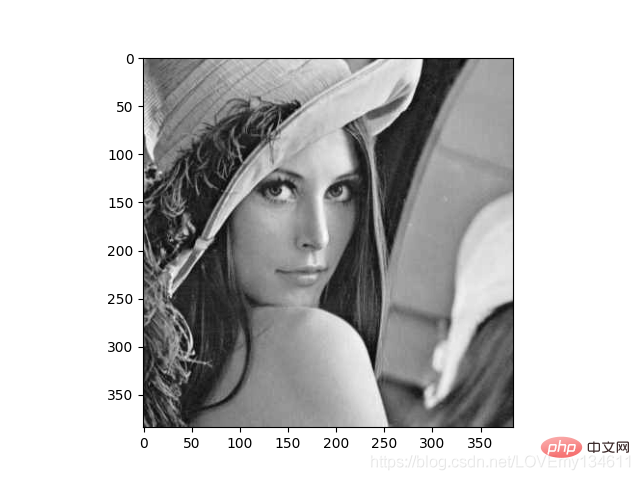
8、 Ilastik
Ilastik 能够给用户提供良好的基于机器学习的生物信息图像分析服务,利用机器学习算法,轻松地分割,分类,跟踪和计数细胞或其他实验数据。大多数操作都是交互式的,并不需要机器学习专业知识。可以参考https://www.ilastik.org/documentation/basics/installation.html进行安装使用。
9、 Scikit-learn
Scikit-learn 是针对 Python 编程语言的免费软件机器学习库。它具有各种分类,回归和聚类算法,包括支持向量机,随机森林,梯度提升,k均值和 DBSCAN 等多种机器学习算法。
使用Scikit-learn实现Introduction aux bibliothèques dapprentissage automatique et dapprentissage profond couramment utilisées en python (partage de résumé)算法:
import timeimport numpy as npimport matplotlib.pyplot as pltfrom sklearn.cluster import MiniBatchIntroduction aux bibliothèques dapprentissage automatique et dapprentissage profond couramment utilisées en python (partage de résumé), Introduction aux bibliothèques dapprentissage automatique et dapprentissage profond couramment utilisées en python (partage de résumé)from sklearn.metrics.pairwise import pairwise_distances_argminfrom sklearn.datasets import make_blobs# Generate sample datanp.random.seed(0)batch_size = 45centers = [[1, 1], [-1, -1], [1, -1]]n_clusters = len(centers)X, labels_true = make_blobs(n_samples=3000, centers=centers, cluster_std=0.7)# Compute clustering with Meansk_means = Introduction aux bibliothèques dapprentissage automatique et dapprentissage profond couramment utilisées en python (partage de résumé)(init='k-means++', n_clusters=3, n_init=10)t0 = time.time()k_means.fit(X)t_batch = time.time() - t0# Compute clustering with MiniBatchIntroduction aux bibliothèques dapprentissage automatique et dapprentissage profond couramment utilisées en python (partage de résumé)mbk = MiniBatchIntroduction aux bibliothèques dapprentissage automatique et dapprentissage profond couramment utilisées en python (partage de résumé)(init='k-means++', n_clusters=3, batch_size=batch_size,
n_init=10, max_no_improvement=10, verbose=0)t0 = time.time()mbk.fit(X)t_mini_batch = time.time() - t0# Plot resultfig = plt.figure(figsize=(8, 3))fig.subplots_adjust(left=0.02, right=0.98, bottom=0.05, top=0.9)colors = ['#4EACC5', '#FF9C34', '#4E9A06']# We want to have the same colors for the same cluster from the# MiniBatchIntroduction aux bibliothèques dapprentissage automatique et dapprentissage profond couramment utilisées en python (partage de résumé) and the Introduction aux bibliothèques dapprentissage automatique et dapprentissage profond couramment utilisées en python (partage de résumé) algorithm. Let's pair the cluster centers per# closest one.k_means_cluster_centers = k_means.cluster_centers_
order = pairwise_distances_argmin(k_means.cluster_centers_,
mbk.cluster_centers_)mbk_means_cluster_centers = mbk.cluster_centers_[order]k_means_labels = pairwise_distances_argmin(X, k_means_cluster_centers)mbk_means_labels = pairwise_distances_argmin(X, mbk_means_cluster_centers)# Introduction aux bibliothèques dapprentissage automatique et dapprentissage profond couramment utilisées en python (partage de résumé)for k, col in zip(range(n_clusters), colors):
my_members = k_means_labels == k
cluster_center = k_means_cluster_centers[k]
plt.plot(X[my_members, 0], X[my_members, 1], 'w',
markerfacecolor=col, marker='.')
plt.plot(cluster_center[0], cluster_center[1], 'o', markerfacecolor=col,
markeredgecolor='k', markersize=6)plt.title('Introduction aux bibliothèques dapprentissage automatique et dapprentissage profond couramment utilisées en python (partage de résumé)')plt.xticks(())plt.yticks(())plt.show()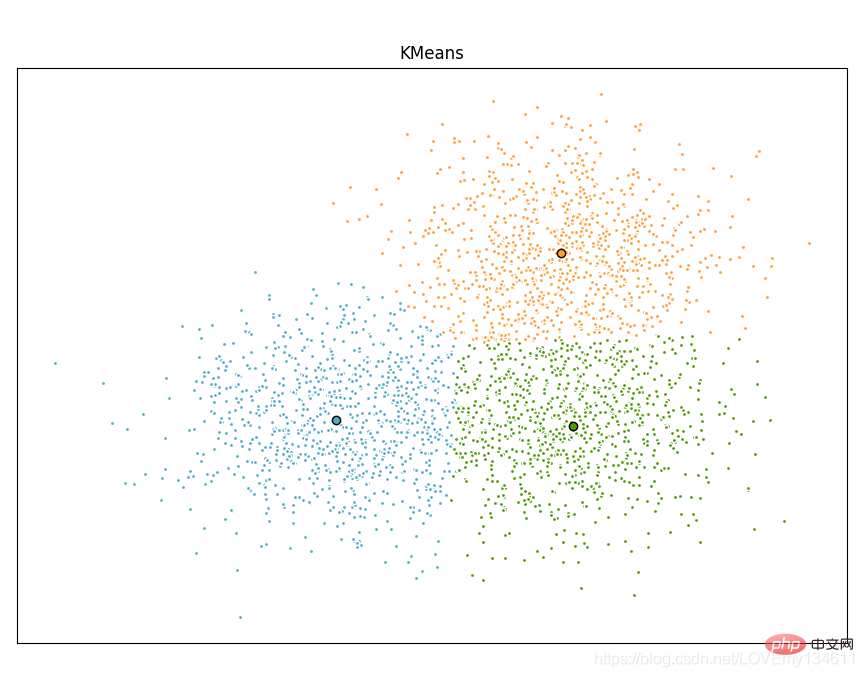
10、 Introduction aux bibliothèques dapprentissage automatique et dapprentissage profond couramment utilisées en python (partage de résumé)
Introduction aux bibliothèques dapprentissage automatique et dapprentissage profond couramment utilisées en python (partage de résumé) 库提供了许多用户友好和高效的数值计算,如数值积分、插值、优化、线性代数等。Introduction aux bibliothèques dapprentissage automatique et dapprentissage profond couramment utilisées en python (partage de résumé) 库定义了许多数学物理的特殊函数,包括椭圆函数、贝塞尔函数、伽马函数、贝塔函数、超几何函数、抛物线圆柱函数等等。
from scipy import specialimport matplotlib.pyplot as pltimport numpy as npdef drumhead_height(n, k, distance, angle, t):
kth_zero = special.jn_zeros(n, k)[-1]
return np.cos(t) * np.cos(n*angle) * special.jn(n, distance*kth_zero)theta = np.r_[0:2*np.pi:50j]radius = np.r_[0:1:50j]x = np.array([r * np.cos(theta) for r in radius])y = np.array([r * np.sin(theta) for r in radius])z = np.array([drumhead_height(1, 1, r, theta, 0.5) for r in radius])fig = plt.figure()ax = fig.add_axes(rect=(0, 0.05, 0.95, 0.95), projection='3d')ax.plot_surface(x, y, z, rstride=1, cstride=1, cmap='RdBu_r', vmin=-0.5, vmax=0.5)ax.set_xlabel('X')ax.set_ylabel('Y')ax.set_xticks(np.arange(-1, 1.1, 0.5))ax.set_yticks(np.arange(-1, 1.1, 0.5))ax.set_zlabel('Z')plt.show()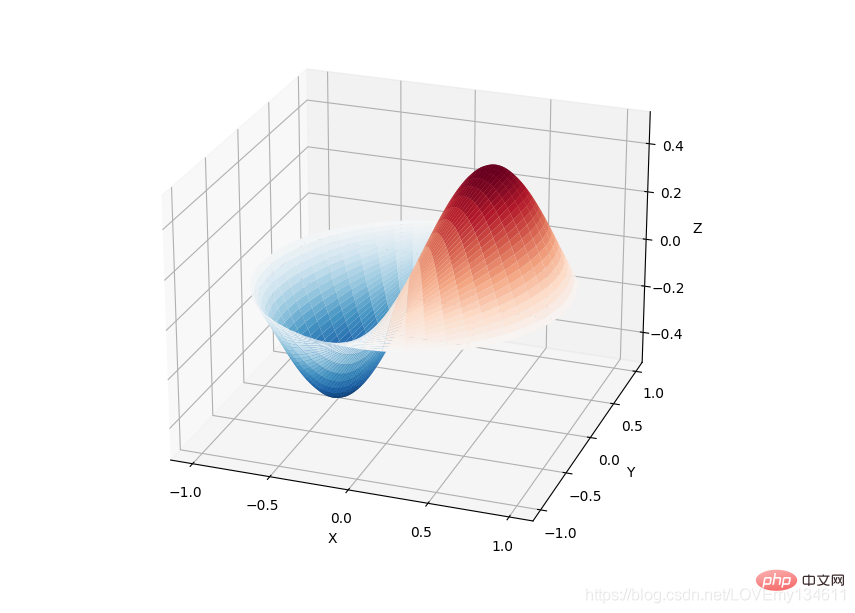
11、 Introduction aux bibliothèques dapprentissage automatique et dapprentissage profond couramment utilisées en python (partage de résumé)
Introduction aux bibliothèques dapprentissage automatique et dapprentissage profond couramment utilisées en python (partage de résumé) 是构建Python程序以处理自然语言的库。它为50多个语料库和词汇资源(如 WordNet )提供了易于使用的接口,以及一套用于分类、分词、词干、标记、解析和语义推理的文本处理库、工业级自然语言处理 (Natural Language Processing, NLP) 库的包装器。
Introduction aux bibliothèques dapprentissage automatique et dapprentissage profond couramment utilisées en python (partage de résumé)被称为 “a wonderful tool for teaching, and working in, computational linguistics using Python”。
import nltkfrom nltk.corpus import treebank# 首次使用需要下载nltk.download('punkt')nltk.download('averaged_perceptron_tagger')nltk.download('maxent_ne_chunker')nltk.download('words')nltk.download('treebank')sentence = """At eight o'clock on Thursday morning Arthur didn't feel very good."""# Tokenizetokens = nltk.word_tokenize(sentence)tagged = nltk.pos_tag(tokens)# Identify named entitiesentities = nltk.chunk.ne_chunk(tagged)# Display a parse treet = treebank.parsed_sents('wsj_0001.mrg')[0]t.draw()
12、 spaCy
spaCy 是一个免费的开源库,用于 Python 中的高级 NLP。它可以用于构建处理大量文本的应用程序;也可以用来构建信息提取或自然语言理解系统,或者对文本进行预处理以进行深度学习。
import spacy
texts = [
"Net income was $9.4 million compared to the prior year of $2.7 million.",
"Revenue exceeded twelve billion dollars, with a loss of $1b.",
]
nlp = spacy.load("en_core_web_sm")
for doc in nlp.pipe(texts, disable=["tok2vec", "tagger", "parser", "attribute_ruler", "lemmatizer"]):
# Do something with the doc here
print([(ent.text, ent.label_) for ent in doc.ents])nlp.pipe 生成 Doc 对象,因此我们可以对它们进行迭代并访问命名实体预测:
[('$9.4 million', 'MONEY'), ('the prior year', 'DATE'), ('$2.7 million', 'MONEY')][('twelve billion dollars', 'MONEY'), ('1b', 'MONEY')]13、 LibROSA
librosa 是一个用于音乐和音频分析的 Python 库,它提供了创建音乐信息检索系统所必需的功能和函数。
# Beat tracking exampleimport librosa# 1. Get the file path to an included audio examplefilename = librosa.example('nutcracker')# 2. Load the audio as a waveform `y`# Store the sampling rate as `sr`y, sr = librosa.load(filename)# 3. Run the default beat trackertempo, beat_frames = librosa.beat.beat_track(y=y, sr=sr)print('Estimated tempo: {:.2f} beats per minute'.format(tempo))# 4. Convert the frame indices of beat events into timestampsbeat_times = librosa.frames_to_time(beat_frames, sr=sr)14、 Introduction aux bibliothèques dapprentissage automatique et dapprentissage profond couramment utilisées en python (partage de résumé)
Introduction aux bibliothèques dapprentissage automatique et dapprentissage profond couramment utilisées en python (partage de résumé) 是一个快速、强大、灵活且易于使用的开源数据分析和操作工具, Introduction aux bibliothèques dapprentissage automatique et dapprentissage profond couramment utilisées en python (partage de résumé) 可以从各种文件格式比如 CSV、JSON、SQL、Microsoft Excel 导入数据,可以对各种数据进行运算操作,比如归并、再成形、选择,还有数据清洗和数据加工特征。Introduction aux bibliothèques dapprentissage automatique et dapprentissage profond couramment utilisées en python (partage de résumé) 广泛应用在学术、金融、统计学等各个数据分析领域。
import matplotlib.pyplot as pltimport pandas as pdimport numpy as np
ts = pd.Series(np.random.randn(1000), index=pd.date_range("1/1/2000", periods=1000))ts = ts.cumsum()df = pd.DataFrame(np.random.randn(1000, 4), index=ts.index, columns=list("ABCD"))df = df.cumsum()df.plot()plt.show()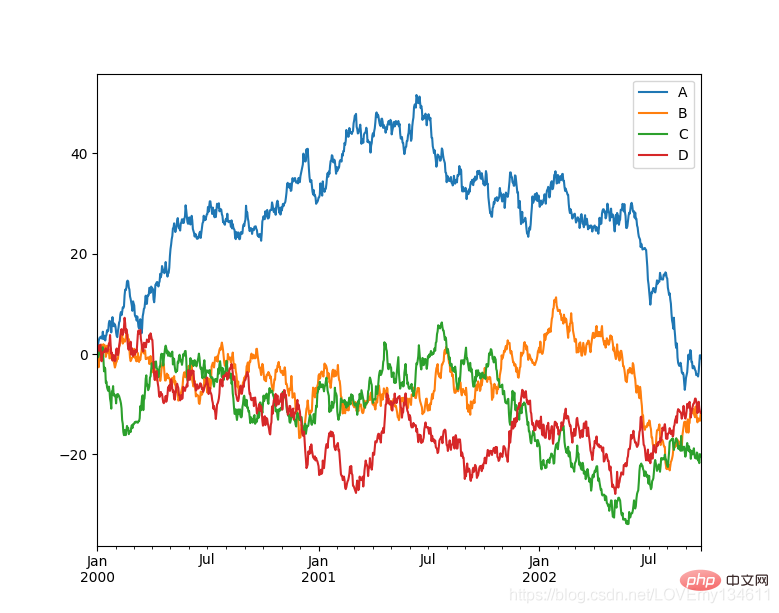
15、 Introduction aux bibliothèques dapprentissage automatique et dapprentissage profond couramment utilisées en python (partage de résumé)
Introduction aux bibliothèques dapprentissage automatique et dapprentissage profond couramment utilisées en python (partage de résumé) 是Python的绘图库,它提供了一整套和 matlab 相似的命令 API,可以生成出版质量级别的精美图形,Introduction aux bibliothèques dapprentissage automatique et dapprentissage profond couramment utilisées en python (partage de résumé) 使绘图变得非常简单,在易用性和性能间取得了优异的平衡。
使用 Introduction aux bibliothèques dapprentissage automatique et dapprentissage profond couramment utilisées en python (partage de résumé) 绘制多曲线图:
# plot_multi_curve.pyimport numpy as npimport matplotlib.pyplot as plt x = np.linspace(0.1, 2 * np.pi, 100)y_1 = x y_2 = np.square(x)y_3 = np.log(x)y_4 = np.sin(x)plt.plot(x,y_1)plt.plot(x,y_2)plt.plot(x,y_3)plt.plot(x,y_4)plt.show()
 有关更多
有关更多Introduction aux bibliothèques dapprentissage automatique et dapprentissage profond couramment utilisées en python (partage de résumé)绘图的介绍可以参考此前博文———Python-Introduction aux bibliothèques dapprentissage automatique et dapprentissage profond couramment utilisées en python (partage de résumé)可视化。
16、 Seaborn
Seaborn 是在 Introduction aux bibliothèques dapprentissage automatique et dapprentissage profond couramment utilisées en python (partage de résumé) 的基础上进行了更高级的API封装的Python数据可视化库,从而使得作图更加容易,应该把 Seaborn 视为 Introduction aux bibliothèques dapprentissage automatique et dapprentissage profond couramment utilisées en python (partage de résumé) 的补充,而不是替代物。
import Introduction aux bibliothèques dapprentissage automatique et dapprentissage profond couramment utilisées en python (partage de résumé) as snsimport matplotlib.pyplot as plt
sns.set_theme(style="ticks")df = sns.load_dataset("penguins")sns.pairplot(df, hue="species")plt.show()
17、 Introduction aux bibliothèques dapprentissage automatique et dapprentissage profond couramment utilisées en python (partage de résumé)
Introduction aux bibliothèques dapprentissage automatique et dapprentissage profond couramment utilisées en python (partage de résumé) 是一个开源的数据挖掘和机器学习软件,提供了一系列的数据探索、可视化、预处理以及建模组件。Introduction aux bibliothèques dapprentissage automatique et dapprentissage profond couramment utilisées en python (partage de résumé) 拥有漂亮直观的交互式用户界面,非常适合新手进行探索性数据分析和可视化展示;同时高级用户也可以将其作为 Python 的一个编程模块进行数据操作和组件开发。
使用 pip 即可安装 Introduction aux bibliothèques dapprentissage automatique et dapprentissage profond couramment utilisées en python (partage de résumé),好评~
$ pip install orange3
安装完成后,在命令行输入 orange-canvas 命令即可启动 Introduction aux bibliothèques dapprentissage automatique et dapprentissage profond couramment utilisées en python (partage de résumé) 图形界面:
$ orange-canvas
启动完成后,即可看到 Introduction aux bibliothèques dapprentissage automatique et dapprentissage profond couramment utilisées en python (partage de résumé) 图形界面,进行各种操作。

18、 PyBrain
PyBrain 是 Python 的模块化机器学习库。它的目标是为机器学习任务和各种预定义的环境提供灵活、易于使用且强大的算法来测试和比较算法。PyBrain 是 Python-Based Reinforcement Learning, Artificial Intelligence and Neural Network Library 的缩写。
我们将利用一个简单的例子来展示 PyBrain 的用法,构建一个多层感知器 (Multi Layer Perceptron, MLP)。
首先,我们创建一个新的前馈网络对象:
from pybrain.structure import FeedForwardNetwork n = FeedForwardNetwork()
接下来,构建输入、隐藏和输出层:
from pybrain.structure import LinearLayer, SigmoidLayer inLayer = LinearLayer(2)hiddenLayer = SigmoidLayer(3)outLayer = LinearLayer(1)
为了使用所构建的层,必须将它们添加到网络中:
n.addInputModule(inLayer)n.addModule(hiddenLayer)n.addOutputModule(outLayer)
可以添加多个输入和输出模块。为了向前计算和反向误差传播,网络必须知道哪些层是输入、哪些层是输出。
这就需要明确确定它们应该如何连接。为此,我们使用最常见的连接类型,全连接层,由 FullConnection 类实现:
from pybrain.structure import FullConnection in_to_hidden = FullConnection(inLayer, hiddenLayer)hidden_to_out = FullConnection(hiddenLayer, outLayer)
与层一样,我们必须明确地将它们添加到网络中:
n.addConnection(in_to_hidden)n.addConnection(hidden_to_out)
所有元素现在都已准备就位,最后,我们需要调用.sortModules()方法使MLP可用:
n.sortModules()
这个调用会执行一些内部初始化,这在使用网络之前是必要的。
19、 Milk
MILK(MACHINE LEARNING TOOLKIT) 是 Python 语言的机器学习工具包。它主要是包含许多分类器比如 SVMS、K-NN、随机森林以及决策树中使用监督分类法,它还可执行特征选择,可以形成不同的例如无监督学习、密切关系传播和由 MILK 支持的 K-means 聚类等分类系统。
使用 MILK 训练一个分类器:
import numpy as npimport milk features = np.random.rand(100,10)labels = np.zeros(100)features[50:] += .5labels[50:] = 1learner = milk.defaultclassifier()model = learner.train(features, labels)# Now you can use the model on new examples:example = np.random.rand(10)print(model.apply(example))example2 = np.random.rand(10)example2 += .5print(model.apply(example2))
20、 TensorFlow
TensorFlow 是一个端到端开源机器学习平台。它拥有一个全面而灵活的生态系统,一般可以将其分为 TensorFlow1.x 和 TensorFlow2.x,TensorFlow1.x 与 TensorFlow2.x 的主要区别在于 TF1.x 使用静态图而 TF2.x 使用Eager Mode动态图。
这里主要使用TensorFlow2.x作为示例,展示在 TensorFlow2.x 中构建卷积神经网络 (Convolutional Neural Network, CNN)。
import tensorflow as tffrom tensorflow.keras import datasets, layers, models# 数据加载(train_images, train_labels), (test_images, test_labels) = datasets.cifar10.load_data()# 数据预处理train_images, test_images = train_images / 255.0, test_images / 255.0# 模型构建model = models.Sequential()model.add(layers.Conv2D(32, (3, 3), activation='relu', input_shape=(32, 32, 3)))model.add(layers.MaxPooling2D((2, 2)))model.add(layers.Conv2D(64, (3, 3), activation='relu'))model.add(layers.MaxPooling2D((2, 2)))model.add(layers.Conv2D(64, (3, 3), activation='relu'))model.add(layers.Flatten())model.add(layers.Dense(64, activation='relu'))model.add(layers.Dense(10))# 模型编译与训练model.compile(optimizer='adam', loss=tf.keras.losses.SparseCategoricalCrossentropy(from_logits=True), metrics=['accuracy'])history = model.fit(train_images, train_labels, epochs=10, validation_data=(test_images, test_labels))
想要了解更多Tensorflow2.x的示例,可以参考专栏 Tensorflow.
21、 PyTorch
PyTorch 的前身是 Torch,其底层和 Torch 框架一样,但是使用 Python 重新写了很多内容,不仅更加灵活,支持动态图,而且提供了 Python 接口。
# 导入库import torchfrom torch import nnfrom torch.utils.data import DataLoaderfrom torchvision import datasetsfrom torchvision.transforms import ToTensor, Lambda, Composeimport matplotlib.pyplot as plt# 模型构建device = "cuda" if torch.cuda.is_available() else "cpu"print("Using {} device".format(device))# Define modelclass NeuralNetwork(nn.Module):
def __init__(self):
super(NeuralNetwork, self).__init__()
self.flatten = nn.Flatten()
self.linear_relu_stack = nn.Sequential(
nn.Linear(28*28, 512),
nn.ReLU(),
nn.Linear(512, 512),
nn.ReLU(),
nn.Linear(512, 10),
nn.ReLU()
)
def forward(self, x):
x = self.flatten(x)
logits = self.linear_relu_stack(x)
return logits
model = NeuralNetwork().to(device)# 损失函数和优化器loss_fn = nn.CrossEntropyLoss()optimizer = torch.optim.SGD(model.parameters(), lr=1e-3)# 模型训练def train(dataloader, model, loss_fn, optimizer):
size = len(dataloader.dataset)
for batch, (X, y) in enumerate(dataloader):
X, y = X.to(device), y.to(device)
# Compute prediction error
pred = model(X)
loss = loss_fn(pred, y)
# Backpropagation
optimizer.zero_grad()
loss.backward()
optimizer.step()
if batch % 100 == 0:
loss, current = loss.item(), batch * len(X)
print(f"loss: {loss:>7f} [{current:>5d}/{size:>5d}]")22、 Theano
Theano 是一个 Python 库,它允许定义、优化和有效地计算涉及多维数组的数学表达式,建在 NumPy 之上。
在 Theano 中实现计算雅可比矩阵:
import theanoimport theano.tensor as T
x = T.dvector('x')y = x ** 2J, updates = theano.scan(lambda i, y,x : T.grad(y[i], x), sequences=T.arange(y.shape[0]), non_sequences=[y,x])f = theano.function([x], J, updates=updates)f([4, 4])23、 Keras
Keras 是一个用 Python 编写的高级神经网络 API,它能够以 TensorFlow, CNTK, 或者 Theano 作为后端运行。Keras 的开发重点是支持快速的实验,能够以最小的时延把想法转换为实验结果。
from keras.models import Sequentialfrom keras.layers import Dense# 模型构建model = Sequential()model.add(Dense(units=64, activation='relu', input_dim=100))model.add(Dense(units=10, activation='softmax'))# 模型编译与训练model.compile(loss='categorical_crossentropy', optimizer='sgd', metrics=['accuracy'])model.fit(x_train, y_train, epochs=5, batch_size=32)
24、 Caffe
在 Caffe2 官方网站上,这样说道:Caffe2 现在是 PyTorch 的一部分。虽然这些 api 将继续工作,但鼓励使用 PyTorch api。
25、 MXNet
MXNet 是一款设计为效率和灵活性的深度学习框架。它允许混合符号编程和命令式编程,从而最大限度提高效率和生产力。
使用 MXNet 构建手写数字识别模型:
import mxnet as mxfrom mxnet import gluonfrom mxnet.gluon import nnfrom mxnet import autograd as agimport mxnet.ndarray as F# 数据加载mnist = mx.test_utils.get_mnist()batch_size = 100train_data = mx.io.NDArrayIter(mnist['train_data'], mnist['train_label'], batch_size, shuffle=True)val_data = mx.io.NDArrayIter(mnist['test_data'], mnist['test_label'], batch_size)# CNN模型class Net(gluon.Block):
def __init__(self, **kwargs):
super(Net, self).__init__(**kwargs)
self.conv1 = nn.Conv2D(20, kernel_size=(5,5))
self.pool1 = nn.MaxPool2D(pool_size=(2,2), strides = (2,2))
self.conv2 = nn.Conv2D(50, kernel_size=(5,5))
self.pool2 = nn.MaxPool2D(pool_size=(2,2), strides = (2,2))
self.fc1 = nn.Dense(500)
self.fc2 = nn.Dense(10)
def forward(self, x):
x = self.pool1(F.tanh(self.conv1(x)))
x = self.pool2(F.tanh(self.conv2(x)))
# 0 means copy over size from corresponding dimension.
# -1 means infer size from the rest of dimensions.
x = x.reshape((0, -1))
x = F.tanh(self.fc1(x))
x = F.tanh(self.fc2(x))
return x
net = Net()# 初始化与优化器定义# set the context on GPU is available otherwise CPUctx = [mx.gpu() if mx.test_utils.list_gpus() else mx.cpu()]net.initialize(mx.init.Xavier(magnitude=2.24), ctx=ctx)trainer = gluon.Trainer(net.collect_params(), 'sgd', {'learning_rate': 0.03})# 模型训练# Use Accuracy as the evaluation metric.metric = mx.metric.Accuracy()softmax_cross_entropy_loss = gluon.loss.SoftmaxCrossEntropyLoss()for i in range(epoch):
# Reset the train data iterator.
train_data.reset()
for batch in train_data:
data = gluon.utils.split_and_load(batch.data[0], ctx_list=ctx, batch_axis=0)
label = gluon.utils.split_and_load(batch.label[0], ctx_list=ctx, batch_axis=0)
outputs = []
# Inside training scope
with ag.record():
for x, y in zip(data, label):
z = net(x)
# Computes softmax cross entropy loss.
loss = softmax_cross_entropy_loss(z, y)
# Backpropogate the error for one iteration.
loss.backward()
outputs.append(z)
metric.update(label, outputs)
trainer.step(batch.data[0].shape[0])
# Gets the evaluation result.
name, acc = metric.get()
# Reset evaluation result to initial state.
metric.reset()
print('training acc at epoch %d: %s=%f'%(i, name, acc))26、 PaddlePaddle
飞桨 (PaddlePaddle) 以百度多年的深度学习技术研究和业务应用为基础,集深度学习核心训练和推理框架、基础模型库、端到端开发套件、丰富的工具组件于一体。是中国首个自主研发、功能完备、开源开放的产业级深度学习平台。
使用 PaddlePaddle 实现 LeNtet5:
# 导入需要的包import paddleimport numpy as npfrom paddle.nn import Conv2D, MaxPool2D, Linear## 组网import paddle.nn.functional as F# 定义 LeNet 网络结构class LeNet(paddle.nn.Layer): def __init__(self, num_classes=1): super(LeNet, self).__init__() # 创建卷积和池化层 # 创建第1个卷积层 self.conv1 = Conv2D(in_channels=1, out_channels=6, kernel_size=5) self.max_pool1 = MaxPool2D(kernel_size=2, stride=2) # 尺寸的逻辑:池化层未改变通道数;当前通道数为6 # 创建第2个卷积层 self.conv2 = Conv2D(in_channels=6, out_channels=16, kernel_size=5) self.max_pool2 = MaxPool2D(kernel_size=2, stride=2) # 创建第3个卷积层 self.conv3 = Conv2D(in_channels=16, out_channels=120, kernel_size=4) # 尺寸的逻辑:输入层将数据拉平[B,C,H,W] -> [B,C*H*W] # 输入size是[28,28],经过三次卷积和两次池化之后,C*H*W等于120 self.fc1 = Linear(in_features=120, out_features=64) # 创建全连接层,第一个全连接层的输出神经元个数为64, 第二个全连接层输出神经元个数为分类标签的类别数 self.fc2 = Linear(in_features=64, out_features=num_classes) # 网络的前向计算过程 def forward(self, x): x = self.conv1(x) # 每个卷积层使用Sigmoid激活函数,后面跟着一个2x2的池化 x = F.sigmoid(x) x = self.max_pool1(x) x = F.sigmoid(x) x = self.conv2(x) x = self.max_pool2(x) x = self.conv3(x) # 尺寸的逻辑:输入层将数据拉平[B,C,H,W] -> [B,C*H*W] x = paddle.reshape(x, [x.shape[0], -1]) x = self.fc1(x) x = F.sigmoid(x) x = self.fc2(x) return x
27、 CNTK
CNTK(Cognitive Toolkit) 是一个深度学习工具包,通过有向图将神经网络描述为一系列计算步骤。在这个有向图中,叶节点表示输入值或网络参数,而其他节点表示对其输入的矩阵运算。CNTK 可以轻松地实现和组合流行的模型类型,如 CNN 等。CNTK 用网络描述语言 (network description language, NDL) 描述一个神经网络。 简单的说,要描述输入的 feature,输入的 label,一些参数,参数和输入之间的计算关系,以及目标节点是什么。
NDLNetworkBuilder=[ run=ndlLR ndlLR=[ # sample and label dimensions SDim=$dimension$ LDim=1 features=Input(SDim, 1) labels=Input(LDim, 1) # parameters to learn B0 = Parameter(4) W0 = Parameter(4, SDim) B = Parameter(LDim) W = Parameter(LDim, 4) # operations t0 = Times(W0, features) z0 = Plus(t0, B0) s0 = Sigmoid(z0) t = Times(W, s0) z = Plus(t, B) s = Sigmoid(z) LR = Logistic(labels, s) EP = SquareError(labels, s) # root nodes FeatureNodes=(features) LabelNodes=(labels) CriteriaNodes=(LR) EvalNodes=(EP) OutputNodes=(s,t,z,s0,W0) ] ]
总结与分类
python 常用机器学习及深度学习库总结
| 库名 | 官方网站 | 简介 |
|---|---|---|
| NumPy | http://www.numpy.org/ | 提供对大型多维阵列的支持,NumPy是计算机视觉中的一个关键库,因为图像可以表示为多维数组,将图像表示为NumPy数组有许多优点 |
| Introduction aux bibliothèques dapprentissage automatique et dapprentissage profond couramment utilisées en python (partage de résumé) | https://opencv.org/ | 开源的计算机视觉库 |
| Introduction aux bibliothèques dapprentissage automatique et dapprentissage profond couramment utilisées en python (partage de résumé) | https:// scikit-image.org/ | 图像处理算法的集合,由scikit-image操作的图像只能是NumPy数组 |
| Python Imaging Library(PIL) | http://www.pythonware.com/products/pil/ | 图像处理库,提供强大的图像处理和图形功能 |
| Pillow | https://pillow.readthedocs.io/ | PIL的一个分支 |
| SimpleCV | http://simplecv.org/ | 计算机视觉框架,提供了处理图像处理的关键功能 |
| Introduction aux bibliothèques dapprentissage automatique et dapprentissage profond couramment utilisées en python (partage de résumé) | https://mahotas.readthedocs.io/ | 提供了用于图像处理和计算机视觉的一组函数,它最初是为生物图像信息学而设计的;但是,现在它在其他领域也发挥了重要作用,它完全基于numpy数组作为其数据类型 |
| Ilastik | http://ilastik.org/ | 用户友好且简单的交互式图像分割、分类和分析工具 |
| Scikit-learn | http://scikit-learn.org/ | 机器学习库,具有各种分类、回归和聚类算法 |
| Introduction aux bibliothèques dapprentissage automatique et dapprentissage profond couramment utilisées en python (partage de résumé) | https://www.scipy.org/ | 科学和技术计算库 |
| Introduction aux bibliothèques dapprentissage automatique et dapprentissage profond couramment utilisées en python (partage de résumé) | https://www.nltk.org/ | 处理自然语言数据的库和程序 |
| spaCy | https://spacy.io/ | 开源软件库,用于Python中的高级自然语言处理 |
| LibROSA | https://librosa.github.io/librosa/ | 用于音乐和音频处理的库 |
| Introduction aux bibliothèques dapprentissage automatique et dapprentissage profond couramment utilisées en python (partage de résumé) | https://pandas.pydata.org/ | 构建在NumPy之上的库,提供高级数据计算工具和易于使用的数据结构 |
| Introduction aux bibliothèques dapprentissage automatique et dapprentissage profond couramment utilisées en python (partage de résumé) | https://matplotlib.org | 绘图库,它提供了一整套和 matlab 相似的命令 API,可以生成所需的出版质量级别的图形 |
| Seaborn | https://Introduction aux bibliothèques dapprentissage automatique et dapprentissage profond couramment utilisées en python (partage de résumé).pydata.org/ | 是建立在Introduction aux bibliothèques dapprentissage automatique et dapprentissage profond couramment utilisées en python (partage de résumé)之上的绘图库 |
| Introduction aux bibliothèques dapprentissage automatique et dapprentissage profond couramment utilisées en python (partage de résumé) | https://orange.biolab.si/ | 面向新手和专家的开源机器学习和数据可视化工具包 |
| PyBrain | http://pybrain.org/ | 机器学习库,为机器学习提供易于使用的最新算法 |
| Milk | http://luispedro.org/software/milk/ | 机器学习工具箱,主要用于监督学习中的多分类问题 |
| TensorFlow | https://www.tensorflow.org/ | 开源的机器学习和深度学习库 |
| PyTorch | https://pytorch.org/ | 开源的机器学习和深度学习库 |
| Theano | http://deeplearning.net/software/theano/ | 用于快速数学表达式、求值和计算的库,已编译为可在CPU和GPU架构上运行 |
| Keras | https://keras.io/ | 高级深度学习库,可以在 TensorFlow、CNTK、Theano 或 Microsoft Cognitive Toolkit 之上运行 |
| Caffe2 | https://caffe2.ai/ | Caffe2 是一个兼具表现力、速度和模块性的深度学习框架,是 Caffe 的实验性重构,能以更灵活的方式组织计算 |
| MXNet | https://mxnet.apache.org/ | 设计为效率和灵活性的深度学习框架,允许混合符号编程和命令式编程 |
| PaddlePaddle | https://www.paddlepaddle.org.cn | 以百度多年的深度学习技术研究和业务应用为基础,集深度学习核心训练和推理框架、基础模型库、端到端开发套件、丰富的工具组件于一体 |
| CNTK | https://cntk.ai/ | 深度学习工具包,通过有向图将神经网络描述为一系列计算步骤。在这个有向图中,叶节点表示输入值或网络参数,而其他节点表示对其输入的矩阵运算 |
Classification
Ces bibliothèques peuvent être classées selon leur objectif principal :
| Catégorie | Bibliothèques |
|---|---|
| Traitement d'images | NumPy, Introduction aux bibliothèques dapprentissage automatique et dapprentissage profond couramment utilisées en python (partage de résumé), scikit image, PIL, Pillow, SimpleCV, Introduction aux bibliothèques dapprentissage automatique et dapprentissage profond couramment utilisées en python (partage de résumé), je |
| Traitement de texte | Introduction aux bibliothèques dapprentissage automatique et dapprentissage profond couramment utilisées en python (partage de résumé), spaCy, NumPy, scikit learn, PyTorch |
| Traitement audio | LibROSA |
| Apprentissage automatique | pandas, scikit-learn, Introduction aux bibliothèques dapprentissage automatique et dapprentissage profond couramment utilisées en python (partage de résumé), , Lait |
| Visualisation des données | Introduction aux bibliothèques dapprentissage automatique et dapprentissage profond couramment utilisées en python (partage de résumé), Seaborn, scikit-learn, Introduction aux bibliothèques dapprentissage automatique et dapprentissage profond couramment utilisées en python (partage de résumé) |
| Deep learning | TensorFlow, Pytorch, Theano, Keras, Caffe2, MXNet, PaddlePaddle, CNTK |
| Informatique scientifique | Introduction aux bibliothèques dapprentissage automatique et dapprentissage profond couramment utilisées en python (partage de résumé) |
Apprentissage recommandé : Tutoriel vidéo Python
Ce qui précède est le contenu détaillé de. pour plus d'informations, suivez d'autres articles connexes sur le site Web de PHP en chinois!

Outils d'IA chauds

Undresser.AI Undress
Application basée sur l'IA pour créer des photos de nu réalistes

AI Clothes Remover
Outil d'IA en ligne pour supprimer les vêtements des photos.

Undress AI Tool
Images de déshabillage gratuites

Clothoff.io
Dissolvant de vêtements AI

AI Hentai Generator
Générez AI Hentai gratuitement.

Article chaud

Outils chauds

Bloc-notes++7.3.1
Éditeur de code facile à utiliser et gratuit

SublimeText3 version chinoise
Version chinoise, très simple à utiliser

Envoyer Studio 13.0.1
Puissant environnement de développement intégré PHP

Dreamweaver CS6
Outils de développement Web visuel

SublimeText3 version Mac
Logiciel d'édition de code au niveau de Dieu (SublimeText3)
 PHP et Python: exemples de code et comparaison
Apr 15, 2025 am 12:07 AM
PHP et Python: exemples de code et comparaison
Apr 15, 2025 am 12:07 AM
PHP et Python ont leurs propres avantages et inconvénients, et le choix dépend des besoins du projet et des préférences personnelles. 1.Php convient au développement rapide et à la maintenance des applications Web à grande échelle. 2. Python domine le domaine de la science des données et de l'apprentissage automatique.
 Comment est la prise en charge du GPU pour Pytorch sur Centos
Apr 14, 2025 pm 06:48 PM
Comment est la prise en charge du GPU pour Pytorch sur Centos
Apr 14, 2025 pm 06:48 PM
Activer l'accélération du GPU Pytorch sur le système CentOS nécessite l'installation de versions CUDA, CUDNN et GPU de Pytorch. Les étapes suivantes vous guideront tout au long du processus: CUDA et CUDNN Installation détermineront la compatibilité de la version CUDA: utilisez la commande NVIDIA-SMI pour afficher la version CUDA prise en charge par votre carte graphique NVIDIA. Par exemple, votre carte graphique MX450 peut prendre en charge CUDA11.1 ou plus. Téléchargez et installez Cudatoolkit: visitez le site officiel de Nvidiacudatoolkit et téléchargez et installez la version correspondante selon la version CUDA la plus élevée prise en charge par votre carte graphique. Installez la bibliothèque CUDNN:
 Explication détaillée du principe docker
Apr 14, 2025 pm 11:57 PM
Explication détaillée du principe docker
Apr 14, 2025 pm 11:57 PM
Docker utilise les fonctionnalités du noyau Linux pour fournir un environnement de fonctionnement d'application efficace et isolé. Son principe de travail est le suivant: 1. Le miroir est utilisé comme modèle en lecture seule, qui contient tout ce dont vous avez besoin pour exécuter l'application; 2. Le Système de fichiers Union (UnionFS) empile plusieurs systèmes de fichiers, ne stockant que les différences, l'économie d'espace et l'accélération; 3. Le démon gère les miroirs et les conteneurs, et le client les utilise pour l'interaction; 4. Les espaces de noms et les CGROUP implémentent l'isolement des conteneurs et les limitations de ressources; 5. Modes de réseau multiples prennent en charge l'interconnexion du conteneur. Ce n'est qu'en comprenant ces concepts principaux que vous pouvez mieux utiliser Docker.
 Python vs JavaScript: communauté, bibliothèques et ressources
Apr 15, 2025 am 12:16 AM
Python vs JavaScript: communauté, bibliothèques et ressources
Apr 15, 2025 am 12:16 AM
Python et JavaScript ont leurs propres avantages et inconvénients en termes de communauté, de bibliothèques et de ressources. 1) La communauté Python est amicale et adaptée aux débutants, mais les ressources de développement frontal ne sont pas aussi riches que JavaScript. 2) Python est puissant dans les bibliothèques de science des données et d'apprentissage automatique, tandis que JavaScript est meilleur dans les bibliothèques et les cadres de développement frontaux. 3) Les deux ont des ressources d'apprentissage riches, mais Python convient pour commencer par des documents officiels, tandis que JavaScript est meilleur avec MDNWEBDOCS. Le choix doit être basé sur les besoins du projet et les intérêts personnels.
 Miniopen Centos Compatibilité
Apr 14, 2025 pm 05:45 PM
Miniopen Centos Compatibilité
Apr 14, 2025 pm 05:45 PM
Minio Object Storage: Déploiement haute performance dans le système Centos System Minio est un système de stockage d'objets distribué haute performance développé sur la base du langage Go, compatible avec Amazons3. Il prend en charge une variété de langages clients, notamment Java, Python, JavaScript et GO. Cet article introduira brièvement l'installation et la compatibilité de Minio sur les systèmes CentOS. Compatibilité de la version CentOS Minio a été vérifiée sur plusieurs versions CentOS, y compris, mais sans s'y limiter: CentOS7.9: fournit un guide d'installation complet couvrant la configuration du cluster, la préparation de l'environnement, les paramètres de fichiers de configuration, le partitionnement du disque et la mini
 Comment faire fonctionner la formation distribuée de Pytorch sur CentOS
Apr 14, 2025 pm 06:36 PM
Comment faire fonctionner la formation distribuée de Pytorch sur CentOS
Apr 14, 2025 pm 06:36 PM
La formation distribuée par Pytorch sur le système CentOS nécessite les étapes suivantes: Installation de Pytorch: La prémisse est que Python et PIP sont installés dans le système CentOS. Selon votre version CUDA, obtenez la commande d'installation appropriée sur le site officiel de Pytorch. Pour la formation du processeur uniquement, vous pouvez utiliser la commande suivante: pipinstalltorchtorchVisionTorChaudio Si vous avez besoin d'une prise en charge du GPU, assurez-vous que la version correspondante de CUDA et CUDNN est installée et utilise la version Pytorch correspondante pour l'installation. Configuration de l'environnement distribué: la formation distribuée nécessite généralement plusieurs machines ou des GPU multiples uniques. Lieu
 Comment choisir la version Pytorch sur Centos
Apr 14, 2025 pm 06:51 PM
Comment choisir la version Pytorch sur Centos
Apr 14, 2025 pm 06:51 PM
Lors de l'installation de Pytorch sur le système CentOS, vous devez sélectionner soigneusement la version appropriée et considérer les facteurs clés suivants: 1. Compatibilité de l'environnement du système: Système d'exploitation: Il est recommandé d'utiliser CentOS7 ou plus. CUDA et CUDNN: La version Pytorch et la version CUDA sont étroitement liées. Par exemple, Pytorch1.9.0 nécessite CUDA11.1, tandis que Pytorch2.0.1 nécessite CUDA11.3. La version CUDNN doit également correspondre à la version CUDA. Avant de sélectionner la version Pytorch, assurez-vous de confirmer que des versions compatibles CUDA et CUDNN ont été installées. Version Python: branche officielle de Pytorch
 Comment installer nginx dans Centos
Apr 14, 2025 pm 08:06 PM
Comment installer nginx dans Centos
Apr 14, 2025 pm 08:06 PM
CENTOS L'installation de Nginx nécessite de suivre les étapes suivantes: Installation de dépendances telles que les outils de développement, le devet PCRE et l'OpenSSL. Téléchargez le package de code source Nginx, dézippez-le et compilez-le et installez-le, et spécifiez le chemin d'installation AS / USR / LOCAL / NGINX. Créez des utilisateurs et des groupes d'utilisateurs de Nginx et définissez les autorisations. Modifiez le fichier de configuration nginx.conf et configurez le port d'écoute et le nom de domaine / adresse IP. Démarrez le service Nginx. Les erreurs communes doivent être prêtées à prêter attention, telles que les problèmes de dépendance, les conflits de port et les erreurs de fichiers de configuration. L'optimisation des performances doit être ajustée en fonction de la situation spécifique, comme l'activation du cache et l'ajustement du nombre de processus de travail.





